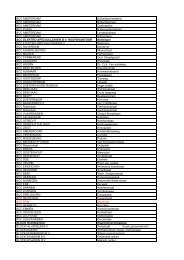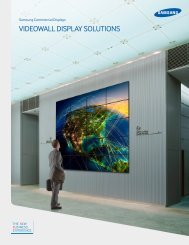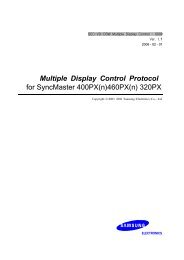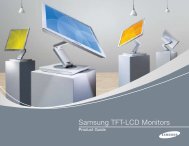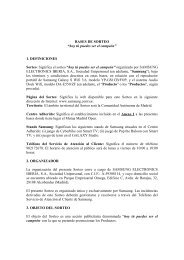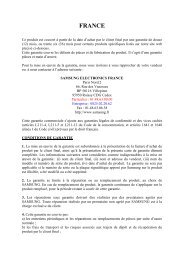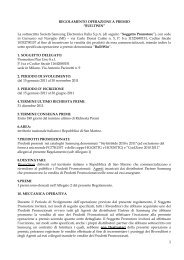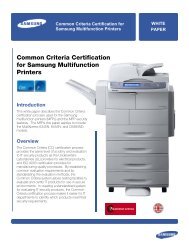2 / Samsung Electronics Sustainability Report 2012 /
2 / Samsung Electronics Sustainability Report 2012 /
2 / Samsung Electronics Sustainability Report 2012 /
Create successful ePaper yourself
Turn your PDF publications into a flip-book with our unique Google optimized e-Paper software.
Stakeholder Communication Effort on the Importance of Water Resources<br />
<strong>Samsung</strong> <strong>Electronics</strong> has recognized the importance of water resource management and has endeavored to communicate our water resource management<br />
policies and the importance of reducing negative environmental impacts. We are openly sharing water quality data on bodies of water in the vicinity<br />
of our operation sites, and we are promoting water quality improvement/ecosystem restoration projects in conjunction with students and NGOs in<br />
local communities.<br />
First, we have designated every Wednesday as a ‘Water Conservation Day’ since 1997. We also installed a Digital Information Display which shows water<br />
resource management tips and conservation methods to help employees contribute to water conservation. We also reduced the pressure in the water<br />
supply line to reduce water use and achieve reductions in operation costs.<br />
Waste Water Discharge and its Impact on Bodies of Water <strong>Samsung</strong> <strong>Electronics</strong> processes all of its waste water through processing facilities before<br />
discharging the treated water into nearby rivers. Some of the domestic and overseas plants located in industrial parks discharge internally treated waste<br />
water into sewage treatment facilities located in the industrial parks for secondary treatment to ensure compliance with relevant legal standards.<br />
We are disclosing information in regards to water quality of waste water discharged from our production facilities so they are informed of our activities.<br />
We are also conducting river ecosystem restoration activities with NGOs to ensure good communication with local community members. Additionally,<br />
we are working with NGOs and students at nearby schools to conduct environmental clean-up activities for biodiversity protection and environmental<br />
conservation.<br />
For example, we have organized environmental cleanup volunteer groups in the U.S. and Hungary. We are collaborating with local governments in Vietnam<br />
to plant aquatic plants and for trash clean-up in local rivers. We are also conducting water conservation activities in all our domestic and overseas<br />
operation sites.<br />
Destination of Discharges<br />
Suwon<br />
Wonchun river<br />
Hwasung<br />
Wonchun river<br />
Aquatic Ecosystem Preservation and Water Quality Improvement Activities The Onyang production plant conducted an environmental impact study<br />
of sewage discharge to nearby rivers in collaboration with a local university. The study was conducted between November 2010 and October 2011 in<br />
collaboration with a local University. The team analyzed water quality characteristics of the discharge from operation sites and the water quality of the<br />
river where treated water is discharged, while studying the concentration of pollution in different parts of the river. The research results indicated that<br />
the water quality of Gokgyo River improved with improved waste water processing effi ciency at the Onyang plant. We will continue to monitor the water<br />
quality of bodies of water near our production plants and implement pollution prevention activities.<br />
Pollution Management<br />
<strong>Samsung</strong> <strong>Electronics</strong> is enforcing an internal environmental standard which is stricter than required by regulations to ensure full compliance. We also<br />
set internal management targets to achieve further reduction and are employing most up-to-date environmental technologies in our new plants. We<br />
have tele-monitoring systems in our production plants for 24-hour pollution management, with emergency response systems in place for handling<br />
abnormal conditions. We also have an internal analysis lab which supports pollution management throughout production processes from its source to<br />
point of releases.<br />
Management of Air Pollutants Global air pollutant release data could not be compiled due to differences in air pollution data management methods<br />
in some countries. Release of the total amount of air pollutants is increasing due to an increase in production volume and an expansion of production<br />
lines. Regardless, we are managing air pollution concentration below legal standards. A separate acidic substance processing method was implemented<br />
on new production lines which began operation in 2011 for improved overall pollution treatment effi ciency over the integrated treatment methods<br />
30 / <strong>Samsung</strong> <strong>Electronics</strong> <strong>Sustainability</strong> <strong>Report</strong> <strong>2012</strong> /<br />
Gumi<br />
Nakdong river<br />
Gwangju<br />
Youngsan river<br />
Giheung<br />
Osan river<br />
Onyang<br />
Gokgyo river<br />
Tangjung<br />
Gokgyo river<br />
Waste water from the Gumi and Gwangju plant is first processed in the internal treatment system, and then transferred to municipal waste water treatment plants.<br />
Cheonan<br />
Cheonan river



